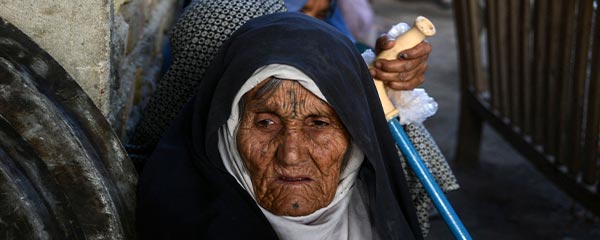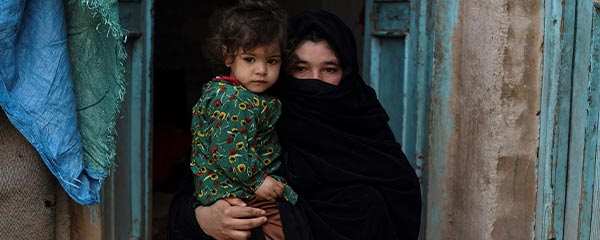Story Highlights
- Majorities in Afghanistan struggle to afford food, shelter
- Just 5% see local economy getting better
- Nearly all Afghans in East struggling to provide basics
WASHINGTON, D.C. -- As many as 1.7 million Afghan refugees living in Pakistan could be forced to return home under the Pakistani government’s “repatriation” plan, which is only likely to further stress Afghanistan’s collapsed economy and swell the already high numbers of Afghans unable to afford food and shelter.
Quick Summary: Citing security risks, Pakistan recently initiated mass deportations of Afghans whom the government says are living in the country illegally. Out of 4 million Afghans living in Pakistan, roughly 1.7 million live there without any documentation. Many have lived there for years, while others arrived more recently, having fled across the border following the Taliban’s takeover in August 2021.
They have now been ordered to leave or face forcible expulsion. Roughly 200,000 have already returned to Afghanistan, with numbers rising by the day.
Mass Inability to Afford Basics Remains
When Gallup surveyed Afghanistan in 2022, near the first anniversary of the Taliban’s takeover, the inability to afford the basics of food and shelter had skyrocketed to the highest rates in the world.
While the pressure has eased slightly in 2023, majorities of Afghans still struggle to afford food (78%) and shelter (69%). These figures remain higher than at any point before the Taliban’s return to power. The International Rescue Committee estimates that poverty affects over 90% of the population.
Some regions of the country are suffering more than others. People in the East universally struggle to afford food (95%) and shelter (95%). All adults living in the East say the local economy is getting worse and rate their lives so poorly that they are considered “suffering.”
The Eastern region borders Pakistan and contains the Torkham crossing, one of the two main crossing points for Afghans leaving Pakistan, the other being Chaman in the Southwest. Thousands have passed through the Torkham crossing in recent days, with the Taliban establishing camps on the other side of the border for people to wait in before being moved on. How the region copes with a mass influx of refugees is yet to be seen.
Economic Hope Still in Short Supply
When the Taliban retook power in Afghanistan, the huge economic shock that followed plunged Afghans into ruin. Nearly all foreign aid was cut off, international financial transactions were halted, the banking system collapsed, and billions of dollars in foreign assets were frozen.
Since then, there have been some modest shoots of economic stability. The exchange rate steadied, and inflation fell from 18.3% in July 2022 to 1.9% in March 2023, according to the World Bank. The Afghani was the world’s best-performing currency in the latest quarter of 2023, driven by billions in humanitarian aid and rising trade with regional neighbors. However, the people of Afghanistan remain deeply pessimistic about their economic future.
Just 5% feel their local economic conditions are getting better, unchanged from 2022. The proportion of people who think the economy is getting worse has dipped from 90% to 81% -- but this is driven by an increase in people who think things are staying the same, not getting better.
This also applies to people’s feelings about their current household income. The proportion finding things “very difficult” has fallen in 2023 (from 71% to 60%), but Afghans have mostly moved to finding things “difficult” (19% to 25%). Still, only 3% are living comfortably on their present income, and just 7% feel it is a good time to find a job, unchanged from 2022.
Less Perceived Corruption, but Little Faith in Institutions
After the Taliban retook power, perceptions of government corruption fell dramatically and remained stable in 2023 at 59%.
This has likely been driven by reported crackdowns on bribery and smuggling, the abolition of separate trade levies that the Taliban imposed as an insurgency before it retook power, and a fall in aid, which was previously highly vulnerable to corruption.
However, Afghans still lack confidence in the financial institutions that run the economy. Just 15% have faith in their financial institutions and banks, on par with last year. In 2022, only Lebanese adults (4%) -- mired by a deep financial crisis -- had less faith than Afghans in their financial institutions.
Bottom Line
Having virtually hit rock bottom in 2022, Afghanistan has achieved some semblance of economic stability this year, albeit at a level that has been described as a “famine equilibrium.” Viewed in a broader context, widespread poverty, instability and pessimism endure, particularly in the East. Humanitarian aid and assistance are urgently needed, according to the United Nations. Women’s rights continue to deteriorate as they vanish from the workforce.
As thousands of Afghans are forced to cross the border from Pakistan, they face an economy unable to accommodate them, where job prospects are bleak, household incomes are squeezed, and millions are unable to afford the basic necessities of food and shelter.
To stay up to date with the latest Gallup News insights and updates, follow us on X.
For complete methodology and specific survey dates, please review Gallup's Country Data Set details.
Learn more about how the Gallup World Poll works.




